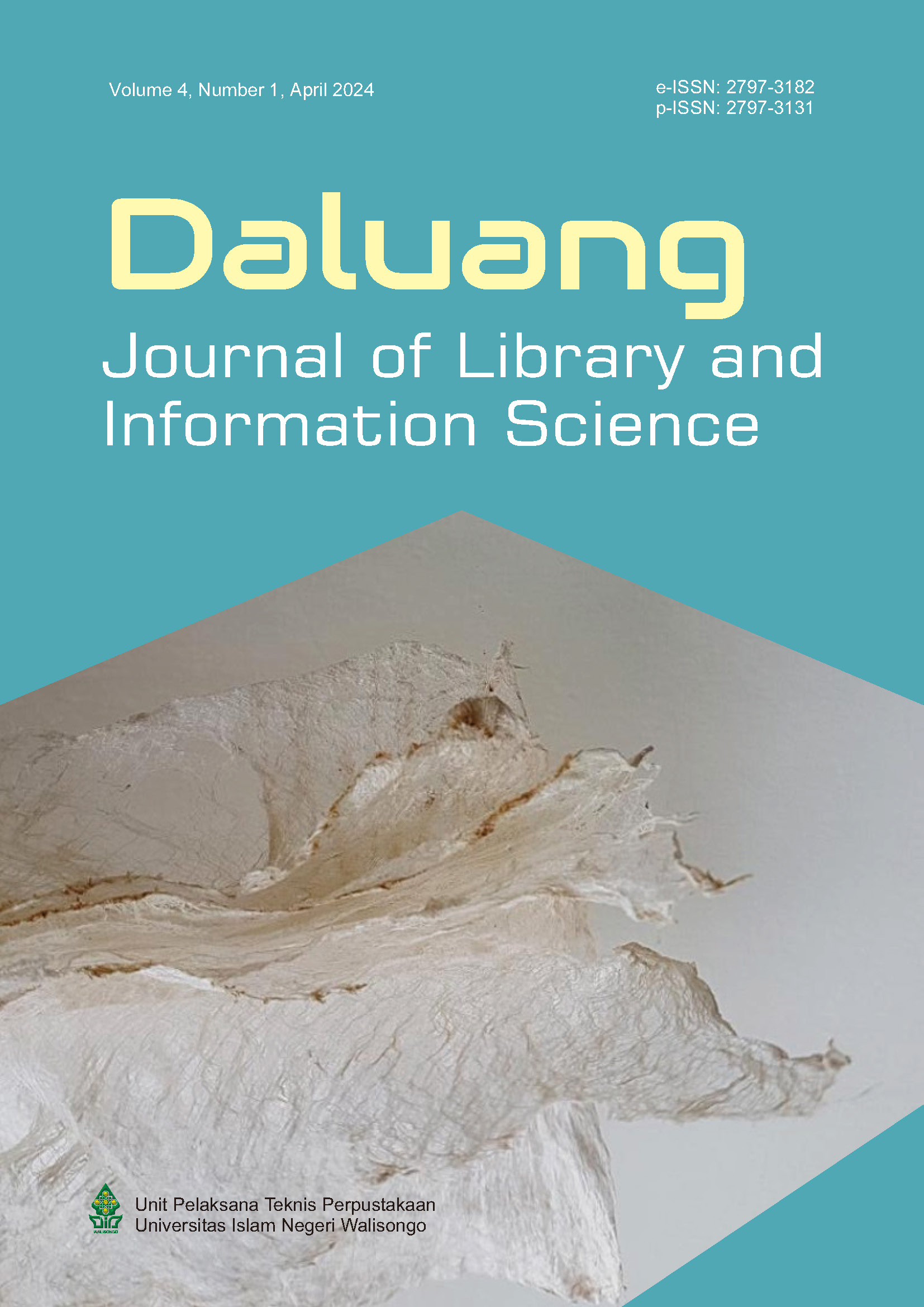Pemetaan visitor and resident dalam keterlibatan individu dengan lingkungan informasi digital
Main Article Content
Abstract
Purpose. The digital ecosystem consists of interactions between customers and partners through various channels, both online and offline, as well as the relationships that exist between digital customers and partners. The ideal interaction between humans, technology, values and activities will be created by ideal ecological information. Thus, system places consumers in an important position connecting customer contacts and contact moments with each other. Including the use of products and virtual visits, such as transactions, emails, educational media, etc. In-depth discussion of individual involvement as information organs (inforgs). Employing the activity-based mapping method, which is intended to determine each person's level of engagement with the digital environment.
Methodology. The method used in this research was a pre-post test on respondents who were at Gadjah Mada University Postgraduate School postgraduate students. Questionnaires were distributed concurrently over the WhatsApp group to conduct the survey. The responses provided by respondents are entered into a Google form.
Results and discussion. This study examines the use of technology and information resources by graduate students at the Graduate School of Gadjah Mada University, also known as "Emergent" education members. There are signs that the way pupils look for knowledge has changed as information and technology have advanced.
Conclusions. The conclusion of this research is that there is a shift in information patterns. Previously, respondents' information patterns were mostly carried out directly by teachers or professors, now they have shifted through scientific websites and become residents through applications on social media.
Downloads
Article Details
This work is licensed under a Creative Commons Attribution-NonCommercial-NoDerivatives 4.0 International License.
Articles published in Daluang Journal of Library and information Science are available under Creative Commons Attribution Non-Commercial No Derivatives Licence (CC BY-NC-ND 4.0). Authors retain copyright in their work and grant Daluang Journal of Library and information Science right of first publication under CC BY-NC-ND 4.0. Users have the right to read, download, copy, distribute, print, search, or link to the full texts of articles in this journal, and to use them for any other lawful purpose.
Articles published in Daluang Journal of Library and information Science can be copied, communicated and shared in their published form for non-commercial purposes provided full attribution is given to the author and the journal. Authors are able to enter into separate, additional contractual arrangements for the non-exclusive distribution of the journal's published version of the work (e.g., post it to an institutional repository or publish it in a book), with an acknowledgment of its initial publication in this journal.
This copyright notice applies to articles published in Daluang Journal of Library and information Science volumes 1 onwards.
References
Belleghem, S. Van. (2014). The internet of customer value. Nexxworks.
Cahyaningtyas, D. F., Adriyana, L., & Primasti, S. A. (2020). Pergeseran perilaku pencarian informasi pada kalangan digital natives. In M. R. Hendrawan (Ed.), Menuju Tata Kelola Informasi: Sebuah Antologi Kepustakawanan. ISIPII Press.
Connaway, L., White, D., Lanclos, D., & Le Cornu, A. (2013). Visitors and residents: What motivates engagement with the digital information environment? Information Research, 18.
Erlianti, G. (2020). Pola perilaku pencarian informasi generasi z berperspektif ellisian. AL Maktabah, 5(1), 1. https://doi.org/10.29300/mkt.v5i1.3135
Ivalina, R. (2019). Pola pencarian informasi di internet. Jurnal Teknodik, 14, 199–216. https://doi.org/10.32550/teknodik.v8i14.530
Lehman-Wilzig, S. N. (2021). Virtuality and reality: Two sides of the same coin bt - virtuality and humanity: Virtual practice and its evolution from pre-history to the 21st century (S. N. Lehman-Wilzig (ed.); pp. 243–260). Springer Singapore. https://doi.org/10.1007/978-981-16-6526-4_12
Nardi, B. A., & O’Day, V. (2000). Information ecologies using technology with heart. The MIT Press.
Phipps, D., Cummins, J., Pepler, D., Craig, W., & Cardinal, S. (2016). The Co-produced pathway to impact describes knowledge mobilization processes. Journal of Community Engagement and Scholarship, 9(1), 31–40. https://doi.org/10.54656/gokh9495
Pradono, J., Hapsari, D., Supardi, S., & Budiarto, W. (2018). Panduan manajemen penelitian kuantitatif (Trihono (ed.)). Penerbit Balitbangkes.
Prensky, M. (2014). Digital natives, digital immigrants. From Digital Natives to Digital Wisdom: Hopeful Essays for 21st Century Learning, 9, 67–85. https://doi.org/10.4135/9781483387765.n6
Riady, Y., Riady, H., Arisanty, M., & Wahyu, M. (2023). Perilaku pencarian informasi mahasiswa magister dan doktor fully online dalam menyelesaikan studi di universitas terbuka. Daluang: Journal of Library and Information Science, 3(1), 57–65. https://doi.org/10.21580/daluang.v3i1.2023.13296
Sugiyono. (2017). Metode penelitian kuantitatif, kualitatif, dan r&d. Alfabeta.
Susanti, D. A. (2012). Ekologi informasi dalam implementasi perpustakaan digital di indonesia : Antara Harapan dan Kenyataan. Edulib, 2(2). https://doi.org/10.17509/edulib.v2i2.10043
White, D. (2017). V&r mapping. https://daveowhite.com/vandr/vr-mapping/
White, D., & Le Cornu, A. (2017). Using ‘visitors and residents’ to visualise digital practices. first monday, 22. https://doi.org/10.5210/fm.v22i8.7802
Zhang, P., & Valley, G. (2019). Toward an interality-oriented philosophy ( IOP ) of the digital. 15(4), 13–22.



